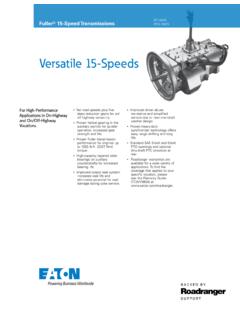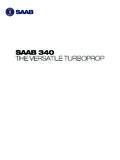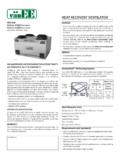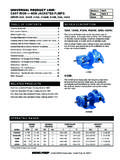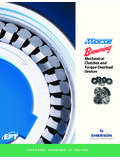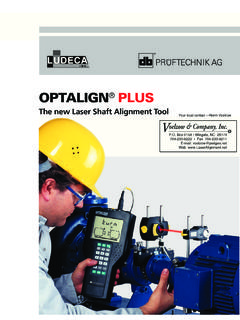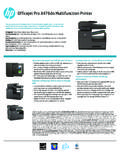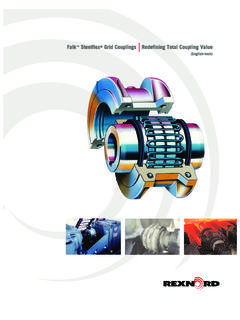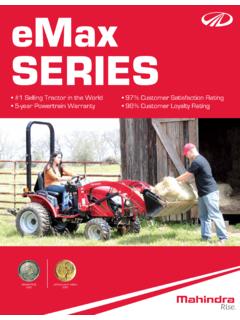Transcription of Sanitaryware & Fittings - The Bathroom Academy
1 1 Industry Guide to Sanitaryware & Fittings Issue 4/11 Copyright 2015 Bathroom Manufacturers AssociationThe Bathroom AcademyStrategic Professionalsin partnership withSanitaryware & Fittings2 Industry Guide to Sanitaryware & Fittings Issue 4/11 Copyright 2015 Bathroom Manufacturers AssociationSanitaryware & FittingsGeneric Industry GuideWelcome to the Sanitaryware and Fittings Generic Industry Guide one in a series of Industry Guides which are available free of charge from the Bathroom Academy Web have aimed to make the contents of the Guides both informative and relevant and hope you will consider them a valuable aid to your continuing professional development and that of your colleagues, within the Bathroom Guide has been written by experts and contains the same five elements: Right choice of product for end user needs Generic industry design Generic industry installation Frequently asked questions Generic industry terminologyThe Sanitaryware & Fittings Generic Industry Guide looks at the vast range of Sanitaryware & Fittings that are available and offers essential information which will allow the Retailer, Merchant and Installer to provide items best suited to the end user needs, whilst the customer s major considerations will be cost, functionality, durability and aesthetics.
2 It is also essential to consider a number of important additional factors; available space, storage requirements and the materials used to manufacture the furniture and its suitability and compatibility with the bathing and/or showering suite within the guides in the series are: Baths Bathroom Furniture Brassware Domestic Water Systems Shower Controls Shower Enclosures Shower Trays Thermostatic Mixing Valves WetroomsAll guides will be downloadable free of charge from to gain evidence and recognition of your knowledge of Sanitaryware and FittingsDid you know that when you have studied the guide in detail you can apply to be assessed and tested on your new found knowledge and if successful, achieve the Sanitaryware and Fittings Bathroom Academy Merit?To find out more about what you need to do to achieve this qualification go Section 1 WCs (Water Closets)
3 Types & Designs - Washdown - Syphonic - Traps & Fittings - Close Coupled - Low Level - High LevelWC Design Solutions - Back to wall / concealed Cistern & Trap - Wall Mounted - Squatting - Fixing WC Pans - WC Bowl Rim Types - Box Rim - Open Rim - RimlessToilet seats - Standard Seat/Cover - Wrapover Style - Soft Closing Mechanism - Germ Resisting - Top Fix - Bottom (conventional) FixSection 2WC Cisterns and FittingsCisternsCistern Fittings - Float Operated Valves - Delayed Action Valves - Silencing DevicesFlushing DevicesPush Button Flush Valves Section 3 Washbasins Types of Washbasins - Wall Mounted - Pedestal - Countertop - Vessel - Belfast Sinks Section 4 Bidets Section 5 Maintenance Section 6 Frequently Asked Questions
4 Section 7 Industry Terminology Section 8 References Contents3 Industry Guide to Sanitaryware & Fittings Issue 4/11 Copyright 2015 Bathroom Manufacturers AssociationIntroductionWhat is Sanitaryware ? Sanitaryware is the generic term used to describe items which traditionally were made from WCs, Washbasins and Bidets installed within a Bathroom or select the most appropriate material from a range of available materials to meet the intended usage of each Used To Manufacture Sanitaryware Vitreous China Fireclay Fine Fireclay Porcelain Enamelled Steel Acrylic Acrylic/Resin Stone Resin Stainless Steel High Impact PlasticVitreous China is the most common material used for the manufacture of Sanitaryware ; WCs Wash basins (wall hung, pedestal and hand rinse) Bidets Urinal bowlsVitreous ChinaVitreous china is made from a mixture of fired white clays and finely ground minerals.
5 The traditional method used to mould Sanitaryware was to pour a finely sieved mixture of water, clays and minerals ( slip ) into Plaster of Paris moulds which form the shape of the appliance. More modern pressure casting methods are commonly used today where multiple resin moulds are filled under pressure on a production line. This reduces labour time and speeds absorbency of the plaster extracted water from the slip in the mould. With pressure casting, it is the high pressure applied which forces the water out. When the clay is dry enough to be self-supporting, the mould is removed. Final trimming (fettling) is carried out while the piece is still soft. Exposed surfaces are then coated with an impervious acid and alkali resistant non-crazing vitreous glaze which today is usually clay piece is fired at around 1200C in a kiln where considerable shrinkage will take place. The finished piece of Sanitaryware is approximately 13% smaller when it comes out of the kiln.
6 FireclayFireclay is an older technology traditionally used when very heavy duty ware is required. The clay body incorporates grog and is of a sufficient strength that it can be used to manufacture heavier items such as shower trays, sinks, slab urinals, hospital Sanitaryware , medical sinks and heavy duty WCs and is widely used for very large Sanitaryware pieces. It is also used to make Belfast type sinks which are very popular in domestic kitchens. Fireclay is solid cast as opposed to hollow cast as is the case with vitreous china. It is moulded in the traditional way in plaster moulds then coated with vitreous glaze to improve the surface, to produce a material that is strong and resistant to heavy usage after firing. The vitreous ceramic glaze is guaranteed against FireclayModern fine fireclay is a blend of refined refractory ball clays and grog . Ball clays are found naturally in the UK in Devon and Dorset. Grog is the term given to ball clays which have been previously fired and ground to a fine particle size, and then added to the pottery Guide to Sanitaryware & Fittings Issue 4/11 Copyright 2015 Bathroom Manufacturers AssociationThe body of the fine fireclay is naturally buff coloured.
7 Since this is unacceptable in a modern Bathroom the body is coated with a white ceramic undercoat called engobe which, in turn is coated with two coats of white glaze. The glaze is tough and firing at around 1200 C the resultant product has a comparatively thick body of sufficient strength to withstand constant rough treatment but unlike vitreous china it is fireclay products include traditional kitchen sinks, cleaners sinks and slab urinals and hairdressers Sanitaryware is extremely robust and naturally resistant. Well manufactured Sanitaryware will be: Stain proof Burn Proof Rot proof Rust proof Fade proof Scratch resistant Slip resistant HygienicPorcelain Enamelled SteelOnly special alloy steels with low carbon content suitable for enamelling are used. The shells are pressed then sprayed with a special enamel ground coat to ensure good chemical bonding with the metal and subsequent finish product is then fired through a furnace at temperatures of 850 C to produce a glass hard permanent lustrous life time finish with good chemical and scratch resistant baths, bath panels, shower trays, shower tray panels and washbasins which are manufactured in this material are warm to the touch, shapely and targeted at the domestic market.
8 They will not rust or corrode but can be damaged by cigarette burns and some sheet with an original thickness usually between 3mm to 10mm is heated until it becomes soft. The sheet is then placed over an aluminium mould, in the shape of the final product, and the air below extracted. The pliable acrylic is sucked into the shape of the mould and the product is formed. This is called vacuum forming .Acrylic sheet can be delicate and when used as a bath it needs to be strengthened. The back of the acrylic is covered with glass reinforced polyester (GRP). Then a timber baseboard and a wooden or steel top frame is applied. Finally the bath is drilled for the waste, overflow and grips and the packaged legset included prior to despatch to the products are versatile and modern in design. They suit a variety of budgets and style preferences. Installation is relatively easy owing to their lighter SteelA wide variety of products are available in stainless steel such as inset and wall hung washbasins, bucket sinks, WCs and urinals.
9 Many stainless steel products are designed to withstand the rigours of prolonged use and possible vandalism but also are used to add different finishes to a building, which complement other materials in the installation. Ranges also include products for use in hospitals and care homes, where the hygienic properties of stainless steel in terms of ease of cleaning contributes to minimising the risk of cross contamination in medical steel products are manufactured by using hydraulic presses, folding, welding and polishing and are engineered to fine tolerances. Many products are made as standard catalogue items but stainless steel is a very versatile and flexible material and can be designed to provide custom made products that fit to the shape and dimensions of a room or layout. There is a wide variety of different polish finishes from matt to high polish which lends the products to be used in a variety of locations from commercial to domestic or designer installations.
10 High Impact Plastic WC seats and concealed cisterns are manufactured from high impact plastic. They are made using the latest injection moulding Impact Polymer ResinWC pans, basins, urinals and accessories can now be manufactured from polymer resin. This provides a finish that looks like ceramic yet is exceptionally hard wearing. Polymer resin Sanitaryware is dent proof, shatterproof, chemical resistant and ideal for use in applications where there is the potential for heavy usage. 5 Industry Guide to Sanitaryware & Fittings Issue 4/11 Copyright 2015 Bathroom Manufacturers AssociationSection 1 WCs (Water Closets)Types and DesignsThere are 2 types of WC: Washdown (box rim, open rim or rimless) SyphonicWashdownThis is by far the most common type of WC installed in the pan is cleared by careful distribution of the force and volume of the flush water. Washdown pans have a 50mm water seal and a convenient bowl shaped to provide efficient cleaning and minimise are normally 400mm high but different shapes are available to suit individual choice.



